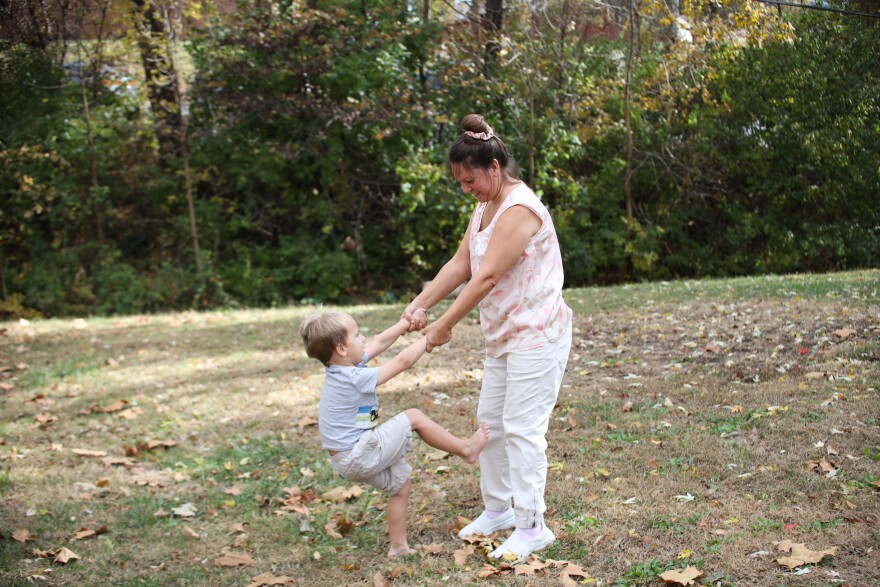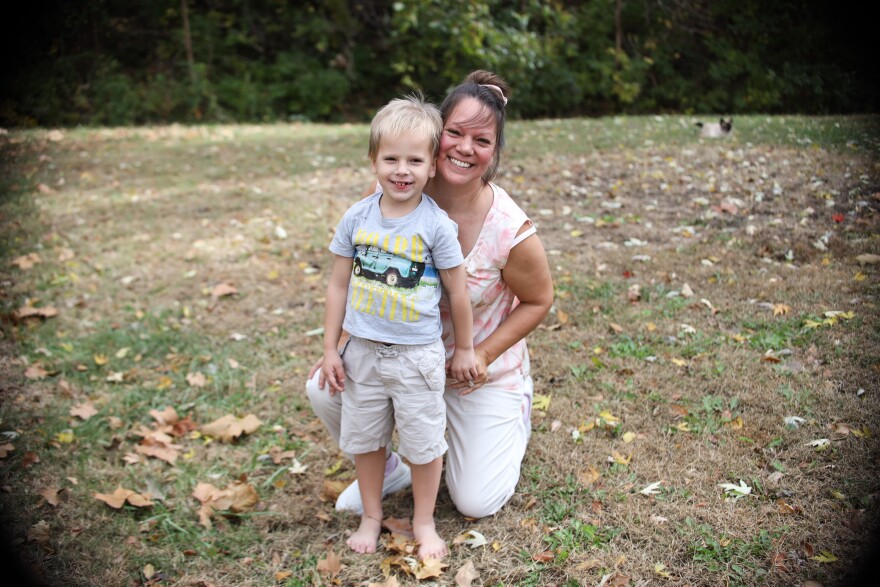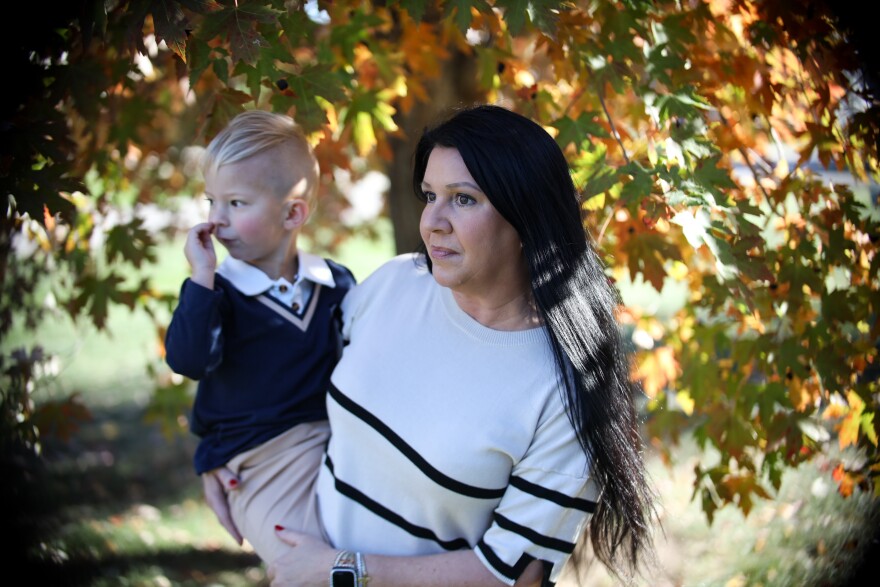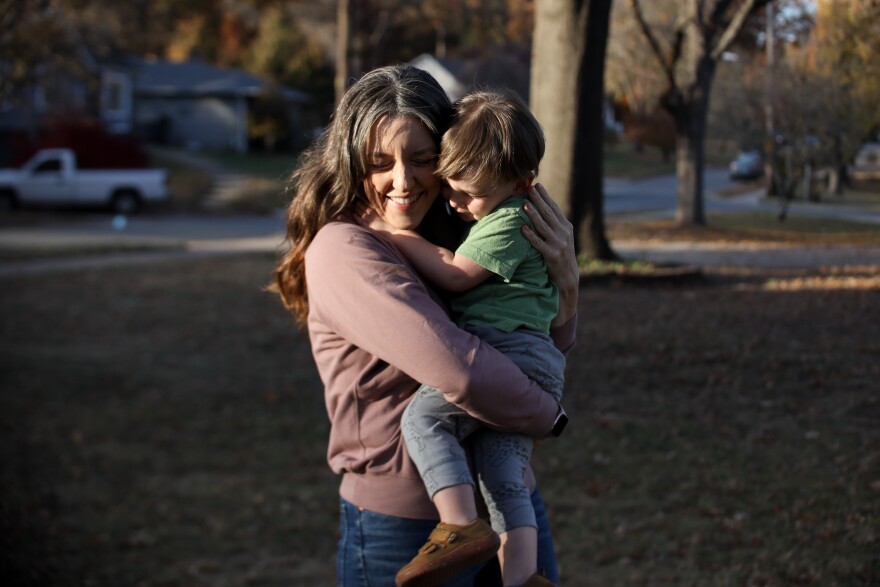ROELAND PARK, Kansas — It’s a warm day in November, and Annie Parsons and her 2-year-old son, River, are raking leaves in their yard in Roeland Park. River has a toddler-sized rake he’s using to scrape the dirt and collect acorns.
Parsons always dreamed of having kids. Her plan was to fall in love, settle down and start having babies by her mid-twenties. But time ticked on, and by the time Parsons was in her late 30s, she had not found a partner to share this dream with.
“The desire to be a mom was stronger than it was to have a partner or to be a wife,” she said, “so I decided to pursue motherhood on my own.”
With the help of in vitro fertilization and a sperm donor, Parsons brought River into the world when she was 41. Stories like hers, where women have babies later in life, are becoming more common.
According to the Centers for Disease Control and Prevention, the amount of moms in their 40s having babies exceeded the amount of teenagers giving birth for the first time. This is not the case in Kansas, where teenage birth rates still exceed the national average. But as birth rates in other age categories decline, the state is also seeing a rise in older moms.
New motherhood after 40
Parsons said there was a lot of heartbreak leading up to River’s birth. It took multiple tries to get pregnant.
Now though, Parsons can’t imagine life any other way.
“In my 20s, I just didn't know myself as well as I do now,” she said. “The fact that I was not a parent earlier in life really allowed me to take some of those risks and to explore my career.”
Parsons said she’s already accomplished her goals in her career and she is financially stable, so now she’s able to have a work-life balance and River can be her main focus.
“I don't feel like I missed anything in the earlier years,” she said. “There's nowhere else that I'd rather be than right here right now and that is a gift.”
There are struggles of course. Parsons said one of the hardest things to adjust to was having the aesthetic of her home, which she carefully decorated, change dramatically. She was so used to being alone that having a little person and their things move in was a lot.
She recently replaced her coffee table with a dedicated table for playing with toy trains.
“There are things that are aesthetically not what I want my house to look like,” Parsons said. “Why are all children's toys primary colors?”
Despite those challenges, Parsons said she feels like she’s living the best years of her life right now, and part of that has to do with when she had River.
“I'm so grateful that none of the ways that I had hoped to become a mom earlier in life worked,” she said. “It’s just such a joy and a privilege to have him and be raising him.”

What experts are saying
According to state data, the majority of babies in Kansas are still born to women aged 25 to 29. But those numbers, along with the overall birthrate, are declining. Births to women aged 40 to 44, however, are increasing.
Between 2013 and 2023, the percentage of all births to moms 40-44 went from 1.9% to 2.6%, an almost 40% increase. Nationally, the increase is even more drastic. Births to women aged 40-44 went from 2.8% in 2013 to 3.8% in 2023.
Sarah Hayford is director of the Institute for Population Research at Ohio State University.
The changes in birth rate trends year to year may seem small, but Hayford said that’s normal for population statistics and the changes add up.
“When we see those small declines continuing to happen for five years or 10 years, then we might say something is going on there and there's really changes happening,” she said.
Hayford said birth rates among women in their teens and 20s are declining drastically. She said this is partially due to people being better able to prevent unplanned pregnancies.
There still isn’t clear data on what those women will do later in life.
“We're not sure yet whether they will have children later on just because they haven't reached those older ages,” Hayford said. “The big declines that we see might be temporary if people sort of catch up.”
Caitlin Linscheid, an OB-GYN in Johnson County, said she’s seen more and more women in their 40s coming in for preconception counseling or prenatal care.
She believes the trend is largely due to three factors: better access to contraceptives, more fertility treatment options and more people choosing to prioritize their careers.
But Linscheid said if you’re considering delaying pregnancy, it’s important to have a conversation with your doctor. Older moms are more likely to have complications like gestational diabetes, preeclampsia or postpartum hemorrhage.
Linsheid said she has to have hard conversations with women who thought they could conceive in their 40s but aren’t able to.
She’s urging women to talk to health care providers well in advance of having children, especially if they’re considering becoming older moms.
“To make sure that your plans allow you to have the family that forms in the way that you want it to when you want it to,” she said.

'Like being a zoo animal'
De Soto resident Esther Reddish-Hanner wasn’t expecting to have a baby in her 40s. She already had four children and was a grandma when she got married in 2017. She said she was shocked when she found herself pregnant a few years later because her husband had been told he was infertile.
After having a miscarriage, she gave birth to her son, Alex, in 2021 at age 44. Reddish-Hanner said the pregnancy was a lot harder than her others.
“I just felt a difference in my body,” she said, explaining that after Alex’s birth she was diagnosed with a vitamin D deficiency. “Being an older parent, I have found it a lot tougher trying to keep my own health up.”
Reddish-Hanner said there’s also a big difference in her parenting style. She said she used to be a stern parent but she’s more patient now.
“I call myself mom, but I'm like grandma mom,” she said. “As an older parent, I do things a lot differently than when I was younger.”

Having a baby later in life also changed financial plans. Reddish-Hanner said her husband, who is 55, plans on retiring later than he originally thought. But she said having Alex felt like a miracle and gave her husband the chance to experience parenthood. She’s also able to take this version of motherhood slower. She isn’t working until Alex goes to school.
“Instead of being forced to work, I'm able to have a choice,” Reddish-Hanner said. “That's what I like about being an older parent, is that before I had no choice. I had to work.”
Another age category that’s having more babies is women 45 and up. According to a report from the CDC, the amount of women having babies in that age category increased by 450% between 1990 and 2023.

Olathe resident Aimee De Vries is one of those moms. She said her pregnancy was really easy, but she was out of the ordinary in the maternity ward.
“It was just kind of like being a zoo animal,” she said, “since I was 45 and pregnant and also a grandma at the time.”
De Vries gave birth to her son, Lucas, in 2023. She said she remarried a few years before that and wanted another baby.
De Vries had her first children, two girls, when she was in her early 20s. She said at this age, parenting is really different. She’s joined Facebook groups for moms in their 40s to find support.
In her 20s, De Vries said she was a strict parent because she had to be. She was a single mom and she said she missed out on a lot of her daughters’ milestones because she had to work.
With Lucas, she gets to stay home and soak it all in.
“I do find a lot more time to sit down and enjoy and take it in rather than thinking everything needs to be perfect,” De Vries said. “That is one thing I can definitely say I really enjoy about starting over again.”
Bek Shackelford-Nwanganga reports on health care disparities and access for the Kansas News Service. You can email her at r.shackelford@kcur.org.
The Kansas News Service is a collaboration of KCUR, Kansas Public Radio, KMUW and High Plains Public Radio focused on health, the social determinants of health and their connection to public policy.
Kansas News Service stories and photos may be republished by news media at no cost with proper attribution and a link to ksnewsservice.org.


